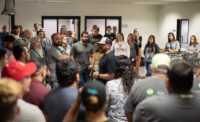The leaders of Corbins Electric are driving fundamental change in the construction industry by infusing innovation in training, technology and workflows to make their projects leaner and faster.
“Everything we do is to solve problems in our industry,” says JD Martin, company vice president. “If it sets Corbins apart so we can win more work that is great, but we are trying to change the industry. We love building projects, but we develop our innovation and technology for the entire industry.”
General contractors have taken note, saying the work the electrical contractor performs makes Corbins Electric a go-to firm.
“The construction industry probably can be a little stagnant,” says Greg Ayres, vice president, Sundt. “Corbins does a phenomenal job with prefabrication and modernization. They can minimize worker hours in the field and that drives top quality work and safety.”
He says while Corbins Electric’s management team should be lauded for creating the structure that energizes the company’s performance, the entire workforce is just as engaged in the concepts of integration and workflow growth.
“From the CEO [Justin Martin] and CFO [Jessica Grant] and everybody from laborers to superintendents to foreman—everyone is great,” Ayres adds.
Justin Martin, Grant and vice presidents Aaron Thompson, Chad Shultz, Michael Vargo and JD Martin officially assumed ownership control of Corbins Electric in January. Both Justin Martin and Grant joined the company about seven years ago and JD Martin about a year later. Shultz, Vargo and vice president Darin Johnson joined the company eight to 10 years ago and Thompson has been with Corbins for nearly 20 years, starting as an apprentice electrician. All of the current leadership worked under former owner Mark Fleming, who purchased the company from founder Bill Corbin.
“I think what Justin has accomplished is an extension of where Mark was headed,” says Adam Rogers, operations manager with Hensel Phelps. “When you did business with Mark, you knew you could trust him. The difference is [that] Justin is really pushing innovation.”
Tech Crunch
Corbins Electric has a decades-long reputation for delivering in the field on such projects as Great Wolf Lodge in Scottsdale, Ariz., for Mortenson and an “undisclosed” $1.5-billion high-tech project for Hensel Phelps in Chandler, Ariz. The company also has a 23,000-sq-ft fabrication shop at its Phoenix headquarters.
Yet Corbins’ approach is broader than simply landing and delivering quality electrical contracting jobs. The company’s approach is also about refining all aspects of the business and providing services to the larger construction industry; this approach simultaneously makes them better at field work, says Justin Martin.
“We cracked that [virtual construction] code with some custom software that we built.”
– Justin Martin, CEO, Corbins Electric
As an early adopter of building information modeling, Corbins also provides those services to companies across the country, Martin says, adding that about 80 company employees are in the virtual construction department, led by Thompson since 2013.
“We cracked that code with some custom software that we built,” Martin says. “We give other contractors an output that they can fabricate off of, and that speeds up the build process.”
More recently, the company partnered with Stockholm-based Hexagon on its Xalt internet of things (IoT) framework. Corbins has leveraged the technology—which is much like a series of apps—into enterprise integration, cloud orchestration, data visualization and built-in mobility. The contractor uses the technology to track financials, worker hours and about 80% of the company’s workflow, says JD Martin.
“There’s full visibility to everything that’s going on in the business to anyone that has a computer, phone or a laptop. And so that’s really helped us be able to respond to needs,” Justin Martin says.
Training Time
Beyond BIM and IoT, Corbins is innovating to solve training and retention efforts. With an ever-increasing need for workers, the company got “intentional” about workforce development in January 2018, says JD Martin. The first move was to move superintendent Matt Apodaca, with a successful background in field-training, into a development and training role.
Recent U.S. Navy veteran Jeff Hammon, a childhood friend of the Martins who has a master’s degree in education, moved from his electrical engineering role to develop the curriculum with Apodaca. The result is an approach that breaks training into skills with about three modules each. All training is done on site and limited to about 90 minutes each, spread over several weeks. Although only four skills have been developed since the approach was formalized in January 2019, JD Martin says the company has identified 50 skills to be applied to apprentices and foremen that will be implemented over the next 18 months.
“We are starting with the basic stuff, he says. “The goal in workforce development is to have 76% completion rate per role.”
Corbins Electric is on the path of modern, successful contractors, says Rodgers, with Hensel Phelps.
“Ten years ago, if you could execute the fundamentals, you could be successful,” he adds. “But today you have to be innovative and dedicated to the process.”




